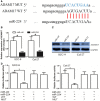MicroRNA-224, negatively regulated by c-jun, inhibits growth and epithelial-to-mesenchymal transition phenotype via targeting ADAM17 in oral squamous cell carcinoma
- PMID: 31207072
- PMCID: PMC6653679
- DOI: 10.1111/jcmm.14107
MicroRNA-224, negatively regulated by c-jun, inhibits growth and epithelial-to-mesenchymal transition phenotype via targeting ADAM17 in oral squamous cell carcinoma
Abstract
Abnormal expression of miR-224 has been reported to promote cancer progression. However, the role of miR-224 is seldom reported in oral squamous cell carcinoma (OSCC). We reported that miR-224 expression was significantly down-regulated in OSCC tissues and cell lines. Restoration of miR-224 decreased OSCC cell growth and invasion. In addition, luciferase and Western blot assays revealed that ADAM17 protein was a downstream target of miR-224. The overexpression of ADAM17 dismissed miR-224's effect on cell growth and invasion. We concluded that miR-224 inhibited OSCC cell growth and invasion through regulating ADAM17 expression. Subsequently, we revealed that c-jun directly bind to miR-224 promoter and decreased miR-224 expression. Taken together, these findings demonstrated that miR-224 may function as a tumour-suppressive microRNA in OSCC and suggested that miR-224 may be a potential therapeutic target for OSCC patients.
Keywords: ADAM17; epithelial-to-mesenchymal transition; miR-224; oral squamous cell carcinoma.
© 2019 The Authors. Journal of Cellular and Molecular Medicine published by John Wiley & Sons Ltd and Foundation for Cellular and Molecular Medicine.
Conflict of interest statement
None declared.
Figures





Similar articles
-
MicroRNA-1258, regulated by c-Myb, inhibits growth and epithelial-to-mesenchymal transition phenotype via targeting SP1 in oral squamous cell carcinoma.J Cell Mol Med. 2019 Apr;23(4):2813-2821. doi: 10.1111/jcmm.14189. Epub 2019 Feb 7. J Cell Mol Med. 2019. PMID: 30734471 Free PMC article.
-
RUNX1/miR-429 feedback loop promotes growth, metastasis, and epithelial-mesenchymal transition in oral squamous cell carcinoma by targeting ITGB1.Naunyn Schmiedebergs Arch Pharmacol. 2024 Jul;397(7):5289-5302. doi: 10.1007/s00210-024-02960-9. Epub 2024 Jan 26. Naunyn Schmiedebergs Arch Pharmacol. 2024. PMID: 38277041
-
LncRNA GAS5 suppresses proliferation, migration, invasion, and epithelial-mesenchymal transition in oral squamous cell carcinoma by regulating the miR-21/PTEN axis.Exp Cell Res. 2019 Jan 15;374(2):365-373. doi: 10.1016/j.yexcr.2018.12.014. Epub 2018 Dec 18. Exp Cell Res. 2019. PMID: 30576678
-
Update of molecular pathobiology in oral cancer: a review.Int J Clin Oncol. 2014;19(3):431-6. doi: 10.1007/s10147-014-0684-4. Epub 2014 Mar 25. Int J Clin Oncol. 2014. PMID: 24664305 Review.
-
The Therapeutic Effects of Mesenchymal Stem Cells and their Secretome on Oral Squamous Cell Carcinoma.Curr Mol Med. 2024;24(10):1195-1207. doi: 10.2174/1566524023666230627151809. Curr Mol Med. 2024. PMID: 37366360 Review.
Cited by
-
ADAM17 Confers Temozolomide Resistance in Human Glioblastoma Cells and miR-145 Regulates Its Expression.Int J Mol Sci. 2023 Apr 22;24(9):7703. doi: 10.3390/ijms24097703. Int J Mol Sci. 2023. PMID: 37175410 Free PMC article.
-
miRNA/mRNA analysis of increased TGF-β pathways drive epithelial-mesenchymal transition and regulatory T cell differentiation.bioRxiv [Preprint]. 2025 Jun 26:2025.06.23.661210. doi: 10.1101/2025.06.23.661210. bioRxiv. 2025. PMID: 40667343 Free PMC article. Preprint.
-
A Potential biomarker for the early diagnosis of OSCC: saliva and serum PrPC.J Cancer. 2024 Jan 21;15(6):1593-1602. doi: 10.7150/jca.92489. eCollection 2024. J Cancer. 2024. PMID: 38370370 Free PMC article.
-
LINC01419 facilitates hepatocellular carcinoma growth and metastasis through targeting EZH2-regulated RECK.Aging (Albany NY). 2020 Jun 10;12(11):11071-11084. doi: 10.18632/aging.103321. Epub 2020 Jun 10. Aging (Albany NY). 2020. PMID: 32522890 Free PMC article.
-
Expression of miR-92a, miR-224 and miR-25 in non-small cell lung cancer and their correlation with clinical characteristics.Am J Transl Res. 2021 May 15;13(5):5561-5567. eCollection 2021. Am J Transl Res. 2021. PMID: 34150158 Free PMC article.
References
MeSH terms
Substances
LinkOut - more resources
Full Text Sources
Medical
Molecular Biology Databases
Miscellaneous

